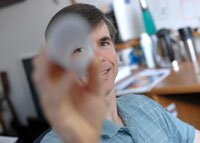FACETIME- Star power: Skrutskie's devices clear the dust

Michael Skrutskie
PHOTO BY JEN FARIELLO
Michael Skrutskie can't remember when he first became fascinated with astronomy. "I was a scientist from birth," he says with a grin. "I was out in the backyard with a telescope when I was six or seven."
He may well have seen his future in those stars: as a respected UVA professor of astronomy, he is the recent winner of the Mulhmann and Watson awards and has just landed a $750,000 National Science Foundation grant for his department.
Skrutskie, 47, moved to Charlottesville in 2001 after earning his PhD at Cornell and teaching at Amherst. While it was tempting to stay in Massachusetts, when UVA offered him a position, the educational opportunities for his family persuaded him to move south.
After six years, he's glad. "It's a wonderful city," Skrutskie says, "and there's strong support for building an astronomy program here."
Skrutskie's work primarily focuses on constructing devices that attach to a telescope and capture detailed images in infrared light invisible to the human eye. The novelty of this technology has permitted important discoveries. "I had the privilege to have my career overlap with the explosion in development of infrared technology," he says. But despite his successes and leadership position, he's still a hands-on kind of guy. "I'm not happy if I'm not holding the screwdriver," he says with a chuckle.
The devices Skrutskie builds allow astronomers to get a look at cooler objects (both interesting and lower in temperature) throughout the universe and see through the dust that clogs scientists' view of many galaxies.
Teaching remains important to Skrutskie as well. "The purpose of my research program here is to give students the opportunity to build instruments and learn the craft," he says.
His recent recognition has been for the Two Micron All Sky Survey for which he was the principal investigator. Now, with that wrapped up, he's excited about the future. Up until now astronomers have not be able to actually see planets orbiting other stars; they can only infer their presence from the way gravity behaves. However, the NSF grant will allow construction of a revolutionary device: "This instrument will have the capability in about two years to directly image planets around other stars," he says.
While Skrutskie is optimistic about this project, John Wilson, his friend and co-worker of nine years, is downright confident. "It's a combination of his energy, his intellect, but also a vision for rich projects that deliver astronomical results," Wilson says. "Everything he touches is successful."
#